Find out why Llewellyn is guarding against any unexpected redecorating in his new lab and why he has a healthy obsession with water
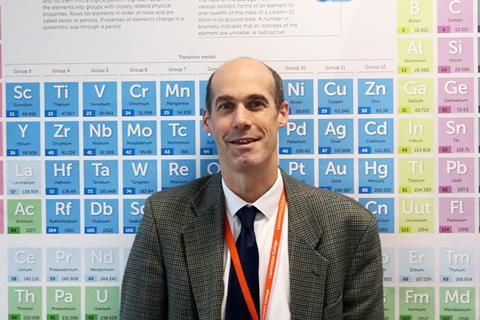
Meet chemistry teacher, Llewellyn Lancaster, who teaches at Launceston College in Cornwall, where he was a pupil from years 7 to 13. He then completed a degree and a chemistry PhD at the University of Exeter, before working on organic reaction mechanisms in ionic liquids in Tom Welton’s group at Imperial College London. In 2005, he started secondary teaching and currently teaches sciences to KS3 and KS4, plus chemistry (and sometimes BTEC applied science) to KS5.
Tell us about Launceston College
When I was student, the labs were very traditional, with hardwood furniture. The chemistry classroom even had eye-level reagent shelves, fully stocked with bottles of dilute acids and alkalis. Things were very different in the 1980s! It was in this room that I learned as a sixth-former why anti-bumping chips are important, having seen the mixture I was heating to reflux hit the ceiling.
Launceston has seen significant population growth over the last 20 years. Launceston College now has over 1400 students and a sixth form with over 100 students. The increasing population in Launceston meant we had to expand our buildings to accommodate our increasing roll. The work began in 2021 and our new science department now has 13 labs, two prep rooms and two seminar rooms.
And what are your new labs like?
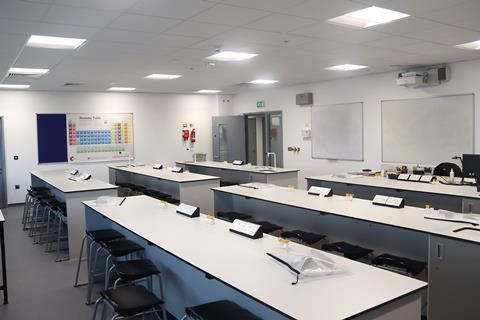
We moved to our new building on 13 November and feel proud to work in what must be the newest purpose-built laboratories in the South West. We feel very fortunate to have had a lot of input into the design of the laboratories.
We could choose several key features, such as fixed benches in three rows, all with clear views of the teacher’s desk and whiteboard. Our generously sized labs are light and airy, and are wide rather than deep, allowing for easy circulation and clear lines of sight. There’s a demonstration space on the teacher’s desk with easy-to-access utilities. We have new projectors and anti-glare whiteboards. Most labs also have a desk to accommodate students who need wheelchairs or have other access needs. When not in use, they fit flush with the fixed benches.
We could choose several key features, such as fixed benches in three rows, all with clear views of the teacher’s desk and whiteboard. Our generously sized labs are light and airy, and are wide rather than deep, allowing for easy circulation and clear lines of sight. There’s a demonstration space on the teacher’s desk with easy-to-access utilities. We have new projectors and anti-glare whiteboards.
The set-up looks very much like a university lab, which is intentional – we want to emphasise this to raise the aspirations and expectations of our students.
How is your teaching space set up?
My lab has two fume cupboards. My post-16 chemistry students immediately noticed this and are eager to use them. This space will make it easier for all students to work simultaneously even when using materials that must be handled in a fume cupboard. Obviously, this includes some steps in synthesis of aspirin, and work investigating the properties of group 7 elements.
My lab has two fume cupboards. My A-level chemistry students immediately noticed this and are eager to use them. This space will make it easier for all students to work simultaneously even when using materials that must be handled in a fume cupboard.
And what makes it unique?
Probably my obsession with water. All chemists would agree that water is properly weird. It has such unexpected properties: it’s a liquid despite low molecular mass; it’s covalent but dissolves ionic substances, the solid is less dense than the liquid; and so many more examples. I always ask my sixth form students to calculate the concentration of water, and then get them to think about what a 1 mol per dm3 solution looks like from the solute’s viewpoint. After all, there are reasons for using 1 M as a standard concentration.
What if you had an unlimited budget?
I would like to have a supply of dry ice and liquid nitrogen. I would use dry ice to illustrate the difference in volumes between solids and gases, demonstrate sublimation and show the acidity of carbon dioxide – drop a piece of dry ice into a tall cylinder of sodium hydroxide solution with universal indicator, and the colour will go from purple through to orange. Liquid nitrogen is great for comparing the strength of the triple covalent bond to the weakness of the intermolecular forces. And I’d love to try making ice cream with liquid nitrogen.
Any thoughts on decorating your lab?
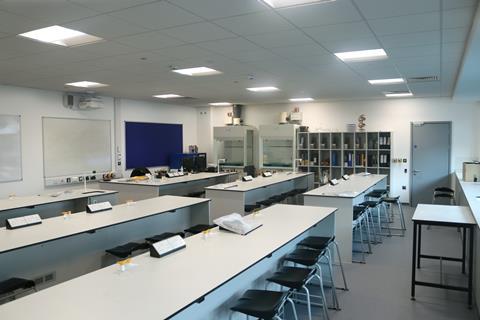
I’m really enjoying making decisions about how I want my new lab to be. I’ve always been in rooms with myriad posters, but have often wondered whether they distract students from learning. I have my RSC periodic table on the wall, but have yet to decide what else to add to the walls. In any presentation, we read the PowerPoint slide before listening to the speaker, so I avoid putting posters on the same wall as my projector screen.
I’m really enjoying making decisions about how I want my new lab to be. I’ve always been in rooms with myriad posters, but wondered whether they distract students. I have my RSC Periodic Table on the wall, but have yet to decide what else to add to walls.
I don’t suppose I’ll ever be the first occupant of a school lab again in my teaching career. When I was at Imperial, Tom’s group moved into a newly refurbished lab. I made my mark there during week one, with an exothermic reaction that got a little excitable – the entire contents of the flask decorated the sash of my new fume hood with a sticky mixture. Hopefully I won’t redecorate my workspace a third time.
Want to see your science department on the pages of EiC? Email education@rsc.org with In my classroom as the subject line.
Show us your teaching space
Want to share your teaching space? Then email us and your favourite space or display could feature in EiC online and in print.






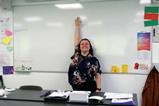
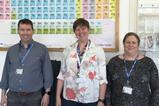






No comments yet